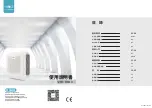
9
MICROPROCESSOR CONTROL
SP007-29
3. OUTDOOR BOARD FUNCTIONALITY
A.
High Pressure Safety Switch (HPSS).
Opens at approx 420 PSIG and closes at approx 320 PSIG. There is no
bypass on this switch. When the switch opens it immediately stops the compressor and outdoor fan. When it
closes the system can restart providing the indoor unit has not entered a P8 fault code. If the switch opens 3
times within a one hour period the outdoor unit operation is “locked out” and must be serviced. The lockout is
reset by turning line voltage off and back on to the outdoor unit. The indoor unit must also be reset to clear the
fault code by turning the remote controller off and back on.
B.
Low Pressure Safety Switch (LPS).
Depending upon the generation of circuit board this switch will open at 7 PSI
or 15 PSI and close at 21 PSI or 30 PSI respectively. The switch is bypassed during the first 3 minutes of cooling
operation and first 10 minutes of heating operation. It is bypassed constantly throughout the defrost cycle plus
10 minutes after completion of defrost. If the switch opens after the specified time the compressor is then
stopped. Once pressure rises to the “cut in” point the compressor may restart providing the delay has expired
and the indoor unit is not in a P8 fault. If the switch opens 3 times within a one hour period the outdoor unit will
be “locked out” and must be serviced. The circuit can be reset by turning off and then resetting line voltage to
the outdoor unit.
C.
Low Ambient Temperature Switch (LATS).
The purpose of this switch is to allow cooling operation in low out-
door temperatures. It functions only during the cooling mode and is ignored in the heat mode. Depending upon
the production period one of two methods have been utilized.
1. The first method uses an outdoor temperature thermostat to cycle the outdoor fan on or off to maintain
head pressure. The switch is located in the electrical compartment of the unit. When outdoor temperature
drops to approx 31 (+/-2) degrees the switch opens and the fan operation is stopped. When the temperature
rises to approx 37 degrees the switch closes and the fan operation is restored.
2. The second and newer method uses a high side pressure switch to cycle the fan. When pressure drops to
150 PSI (+/-15) the switch opens and the fan stops. When pressure rises to 225 the switch closes and the fan
restarts. This method provides a more reliable method of low ambient cooling than that of the temperature
switch. To convert a “temperature switch” unit to a “pressure switch” unit, order Part Number GPN490001.
3. During low ambient cooling operation the indoor unit may initiate an “air defrost” of the indoor coil once
during every 16 minutes of continuous cooling operation. This insures that the coil has adequate airflow and
should not be considered as a fault.
D.
Defrost Sensor Switch (DFT).
The defrost switch is set to close at 35 degrees (+/-7) and opens at 65 degrees (+/-5).
The board is factory set with a 60 minute minimum defrost interval and can be reset to 30 or 90 minutes by
moving a jumper. When the defrost sensor closes, the defrost timer begins timing out the compressor run time.
Once the timer “times out” (30/60/90 minutes) and the switch is closed the reversing valve is shifted and defrost
is accomplished. If the room temperature is satisfied during a defrost cycle, the defrosting will continue until the
termination temperature is achieved or 10 minutes has elapsed.
E.
Crankcase Heater (CCH).
A 40 watt crankcase heater is installed into all PUG and PUGH condensing units to pro-
vide additional protection to the compressor when operating under low ambient conditions. When line voltage is
first turned onto the outdoor unit the crankcase heater will be energized. The CCH will continue to be energized
until the first call for compressor operation. The CCH never runs during compressor operation. Thirty minutes
after the compressor turns off the CCH will again be energized. It will then cycle on for 30 minutes and off for 30
minutes repeatedly until the compressor is again turned on.
F.
Reversing Valve (RXV).
Fails to cooling and energizes when the system is set to the heat mode. Heat mode oper-
ation is initiated when the indoor unit provides a 12VDC signal on the #3 low voltage control wire. The reversing
valve is then energized with 24VAC and remains energized continuously throughout the heating mode (not just
during compressor operation), with the exception of defrost cycles. When the outdoor unit enters defrost the
RXV will shift on the fly.
G.
Compressor Contactor (CC).
The compressor contactor is energized with 24VAC when a 12 VDC is input to the
outdoor unit on control wires 1 and 2 from the indoor unit. This 12 VDC signal is generated and sent from the
indoor unit on all calls for compressor operation regardless of heating or cooling.
H.
Outdoor Fan Motor (ODF).
The outdoor fan motor typically operates at the same time as the compressor. There
are however some exceptions to this. The fan may be off while the compressor is operating during low ambient
cooling conditions. This is controlled by the LATS as identified above. The fan is also cycled off during defrost-
ing operations to speed elimination of frost from the outdoor coil.
I.
Transformer Input (24VAC).
The secondary side of the transformer inputs 24 volts AC to the circuit board on the
“24VAC” terminals. This voltage operates the internal circuits of the board and also provides voltage to the
reversing valve and compressor contactor when appropriate. The primary side of the transformer picks up line
voltage from terminals marked “L1” and “L2” on the board.
















































